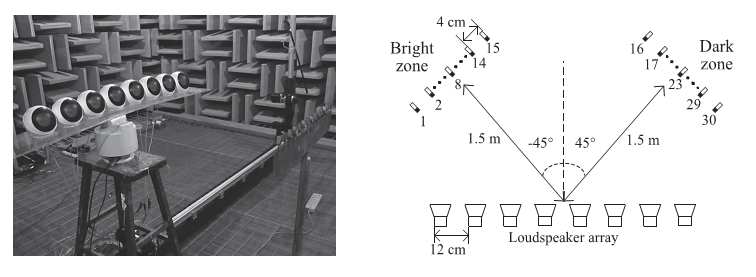
Sound Reproduction in Personal Audio Systems Using the Least-squares Approach with Acoustic Contrast Control Constraint
May 22, 2014 Email"> PrintText Size

Personal audio systems focus sound around the user by utilizing a set of loudspeakers. These systems can provide individuals with a private listening space without disturbing other people. One common method for implementing personal audio systems, namely, acoustic contrast control (ACC), aims to maximize the ratio of acoustic potential energy density between the bright and the dark zones. By contrast, the spatial average error between the desired and reproduced field is usually considered in sound field reproduction (SFR) systems, where wave field synthesis, Ambisonics, and least-squares (LS) approaches are usually used.
Researchers from the Institute of Acoustics, Chinese Academy of Sciences focus on the problem of local sound reproduction in personal audio systems. They propose an approach that integrates LS-based SFR with the ACC constraint and introduces a constrained parameter that denotes the minimum maintained acoustic contrast. Spatial average error is minimized only when the acoustic contrast is larger than the value of the constrained parameter.
The novel method focuses on the reproduced sound in the bright zone without disturbing other people in the dark zone in personal audio systems. It combines the least-squares and acoustic contrast criteria. Besides, a constrained parameter is introduced to tune the balance between two performance indices, namely, the acoustic contrast and the spatial average error. As well, an efficient implementation of this method using convex optimization is presented.
Offline simulations and real-time experiments are conducted to evaluate the presented method using linear loudspeaker array (Fig. 1) based on various performance criteria, such as acoustic contrast, spatial average error, frequency response, spatial distribution of the sound pressure level, and loudspeaker weight energy. Results show that compared with the traditional acoustic contrast control method, the proposed method can improve the flatness of response in the bright zone by sacrificing the level of acoustic contrast.

Fig. 1 Linear array consisting of 8loudspeakers spaced 12 cm apart. Both the bright and dark zones are represented by 15 control points spaced 4 cm apart. (a) Setup of the measurements in the anechoic chamber; (b) schematic of the experimental setup (Image by IOA).
This research was supported by National Natural Science Fund of China under Grant Nos. 11004217, 11074279, 11174317, and 11304349.
Journal References:
CAI Yefeng, WU Ming and YANG Jun. Sound Reproduction in Personal Audio Systems Using the Least-squares Approach with Acoustic Contrast Control Constraint. JOURNAL OF THE ACOUSTICAL SOCIETY OF AMERICA (vol. 135, no. 2, pp. 734-741, FEB 2014). DOI: 10.1121/1.4861341
Corresponding author:
YANG Jun
Key Laboratory of Noise and Vibration Research, Institute of Acoustics, Chinese Academy of Sciences, Beijing 100190, China
E-mail: jyang@mail.ioa.ac.cn
Personal audio systems focus sound around the user by utilizing a set of loudspeakers. These systems can provide individuals with a private listening space without disturbing other people. One common method for implementing personal audio systems, namely, acoustic contrast control (ACC), aims to maximize the ratio of acoustic potential energy density between the bright and the dark zones. By contrast, the spatial average error between the desired and reproduced field is usually considered in sound field reproduction (SFR) systems, where wave field synthesis, Ambisonics, and least-squares (LS) approaches are usually used.
Researchers from the Institute of Acoustics, Chinese Academy of Sciences focus on the problem of local sound reproduction in personal audio systems. They propose an approach that integrates LS-based SFR with the ACC constraint and introduces a constrained parameter that denotes the minimum maintained acoustic contrast. Spatial average error is minimized only when the acoustic contrast is larger than the value of the constrained parameter.
The novel method focuses on the reproduced sound in the bright zone without disturbing other people in the dark zone in personal audio systems. It combines the least-squares and acoustic contrast criteria. Besides, a constrained parameter is introduced to tune the balance between two performance indices, namely, the acoustic contrast and the spatial average error. As well, an efficient implementation of this method using convex optimization is presented.
Offline simulations and real-time experiments are conducted to evaluate the presented method using linear loudspeaker array (Fig. 1) based on various performance criteria, such as acoustic contrast, spatial average error, frequency response, spatial distribution of the sound pressure level, and loudspeaker weight energy. Results show that compared with the traditional acoustic contrast control method, the proposed method can improve the flatness of response in the bright zone by sacrificing the level of acoustic contrast.

Fig. 1 Linear array consisting of 8loudspeakers spaced 12 cm apart. Both the bright and dark zones are represented by 15 control points spaced 4 cm apart. (a) Setup of the measurements in the anechoic chamber; (b) schematic of the experimental setup (Image by IOA).
This research was supported by National Natural Science Fund of China under Grant Nos. 11004217, 11074279, 11174317, and 11304349.
Journal References:
CAI Yefeng, WU Ming and YANG Jun. Sound Reproduction in Personal Audio Systems Using the Least-squares Approach with Acoustic Contrast Control Constraint. JOURNAL OF THE ACOUSTICAL SOCIETY OF AMERICA (vol. 135, no. 2, pp. 734-741, FEB 2014). DOI: 10.1121/1.4861341
Corresponding author:
YANG Jun
Key Laboratory of Noise and Vibration Research, Institute of Acoustics, Chinese Academy of Sciences, Beijing 100190, China
E-mail: jyang@mail.ioa.ac.cn
CAS Institutes
There are 124 Institutions directly under the CAS by the end of 2012, with 104 research institutes, five universities & supporting organizations, 12 management organizations that consist of the headquarters and branches, and three other units. Moreover, there are 25 legal entities affiliated and 22 CAS invested holding enterprisesThere are 124 I...>> more
Contact Us

Chinese Academy of Sciences
Add: 52 Sanlihe Rd., Xicheng District, Beijing, China
Postcode: 100864
Tel: 86-10-68597592 (day) 86-10-68597289 (night)
Fax: 86-10-68511095 (day) 86-10-68512458 (night)
E-mail: cas_en@cas.cn

